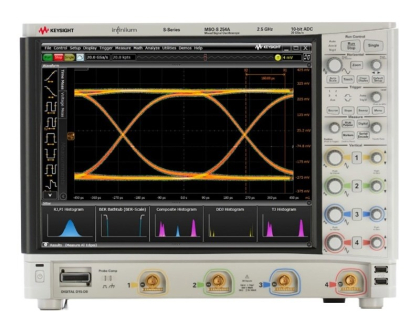Scopes Get a Second Look with Integrated Analyzers
June 07, 2023
 |
Oscilloscopes and spectrum analyzers are two of the most essential electronic test equipment, offering two views of electrical energy. An oscilloscope shows signals in the time domain, plotting amplitude versus time. A spectrum analyzer shows signals in the frequency domain, with amplitude displayed versus frequency. The different views can be useful when tracing faults in circuits, especially with mixed signals. These test units help analyze continuous-wave (CW), radio-frequency (RF), pulsed, and a variety of different electronic signals, with insights provided by the mixed signal domains. Traditionally, testing in the time and frequency domains meant separate signal paths and separate units. However, a more efficient approach—and a less crowded test bench—can be achieved using a high-speed oscilloscope with on-board spectrum analysis capability. That way, it is possible to have multiple looks at a signal of interest with a single unit.
Oscilloscopes have long been workhorse equipment for measuring AC and DC voltages of various waveforms, such as sinewaves and square waves. They are available for analyzing high-speed signals and, with suitable test probes, can show the effects of design changes to a circuit and how variations in operating conditions can affect electronic performance over time. Some modern oscilloscopes add the convenience of spectrum analysis capability, either in software or hardware form. Oscilloscopes with software spectrum analyzers apply digital signal processing (DSP) to captured signal data to create a spectral display of signal amplitude versus frequency much like the screen of a traditional spectrum analyzer. Some oscilloscopes integrate a spectrum analyzer receiver printed-circuit board (PCB) or module within their cabinets so that separate units reside within the same housing and control center.
Specifying a combination oscilloscope/spectrum analyzer requires defining performance ranges for the two units, so that each will deliver the capabilities needed for a targeted set of test applications. For an oscilloscope, this typically includes the number of measurement channels, bandwidth per channel, sample rate, vertical bit resolution, trigger level range, time base range, noise floor, and acceptable jitter. For a spectrum analyzer, it is number of channels, frequency range, acquisition bandwidth range, frequency resolution, and minimum/maximum signal power or dynamic range. Whether for design, manufacturing, or in-field testing, a single unit with the features of both units and with a practical user interface can reduce clutter and increase measurement power.
Probing Combinations
As an example, 3 Series mixed domain oscilloscopes (MDOs) from Tektronix start with a high-performance oscilloscope with options for a hardware spectrum analyzer and integrated arbitrary waveform generator. The Tektronix MDO34 provides four oscilloscope channels with as much as 1-GHz bandwidth with model TekVPI probes. It captures signals across a wide time base range of 400 ps/div to 1000 s/div, with more than 125 trigger combinations. It shows test results with 8-b vertical resolution on a 11.6-in. (295-mm) wide touch-panel display screen. To speed and simplify measurements, it integrates a frequency counter and a four-digital digital voltmeter (DVM).
To explore inputs in the frequency domain, an optional spectrum analyzer provides a front-panel Type N coaxial connector. The basic version covers 9 kHz to 1 GHz and is available with a higher-frequency option with a range of 9 kHz to 3 GHz and capture bandwidth of 3 GHz in a single sweep. The reference level can be set from -140 to +20 dBm and the spectrum analyzer can handle CW signals to +33 dBm and short pulsed signals to +45 dBm without damage. The analyzer has noise levels typically of -109 dBm/Hz at 50 kHz and lower frequencies and -126 dBm/Hz above 50 kHz. To add to the versatility, the MDO34 contains a host of automated measurements, including channel power, adjacent channel power ratio, and occupied bandwidth, and details slowly changing RF signals on a spectrogram display. The multiple physical units are contained in a portable housing with handle measuring 9.93 × 14.57 × 5.85 in. (252 × 370 × 148.6 mm) and weighing 11.7 lbs. (5.31 kg).
The MDO34 is noteworthy for a simple user interface, employing small rectangular control badges at the bottom of display screen. These controls can switch on and off oscilloscope channels, turn on the spectrum analyzer, and even activate an integrated DVM. For equipment including the optional arbitrary function generator, the touch button controls can command test signals from 0.1 Hz to 50 MHz in a variety of formats, including sine waves, square waves, pulses, and noise.
When a 1-GHz oscilloscope bandwidth is adequate but spectrum analysis beyond 3 GHz is needed, the Tektronix MDO4104C teams an MDO having four 1-GHz analog oscilloscope channels with an RF/microwave spectrum analyzer. Options are available for the spectrum analyzer with frequency ranges of 9 kHz to 3 GHz as well as 9 kHz to 6 GHz, both with 1-Hz frequency resolution. This combination unit is also available with an optional integral 16-channel logic analyzer, all within a housing measuring 9.0 × 17.3 × 5.8 in. (229 × 439 × 147 mm) and weighing 12.2 lbs. (5.5 kg).
In contrast, the Keysight MSOS254A oscilloscope provides spectrum analysis by means of extensive on-board DSP capabilities. It does not require a dedicated coaxial input signal connection to a physically separate spectrum analyzer module contained within the unit. Model MSOS254A features a 2.5-GHz bandwidth with 4 analog and 16 digital input channels. It provides strong processing power with sampling rates as high as 20 GSamples/s per channel when using two channels and as fast as 10 GSamples/s per channel when using four channels. It features memory depth of 800 Mpoints/channel for two channels and 400 Mpoints/channel for four channels.
A member of the company’s Infiniium S-series lineup of oscilloscopes, it shows test results on a 15-in.-wide capacitive touchscreen XGA display with 1024 × 768-pixel resolution. The oscilloscope leverages a high-performance 10-b analog-to-digital converter (ADC) and Intel i5 quad-core microprocessor running the Windows 10 operating system (OS) from Microsoft Corp. It includes 8 GB random access memory (RAM) and removable 256-GB solid-state-drive (SSD) memory. With the large display screen, it is slightly larger than the other oscilloscope/spectrum analyzers, at 12.9 × 16.8 × 9.0 in. (33 × 43 × 23 cm) and a robust 26.5 lbs. (12 kg).
Using fast Fourier transforms, (FFTs), it converts time-domain data to the frequency domain for its spectrum analyzer displays. It is capable of as many as 20 measurements at once and achieves spectrum analyzer signal sensitivity as good as -160 dBm/Hz. FFT functions include controls familiar to most spectrum analyzer users, such as setting start and stop frequencies, resolution bandwidth, center frequency, and frequency span, to achieve a desired spectral analysis display. In addition, gated FFTs can provide high-resolution views of a signal or waveform, using time-correlated or envelope measurements to highlight a signal of interest, such as the rise time of a pulsed signal. As an option, the model MSOS254A oscilloscope can be equipped with vector signal analysis (VSA) software to study complex signals and modulated waveforms.
When a wider frequency range is needed, the Keysight DSOX6004A provides 6 GHz bandwidth across 4 analog and 16 digital input channels with maximum sampling rate of 20 GSamples/s per channel. It has a slightly smaller, 12.1-in. multiple-touch display screen, but with impressive graphical resolution and capable of generating real-time eye diagrams for signal integrity (SI) testing. As with the MSOS254A oscilloscope, the model DSOX6004A oscilloscope uses FFT signal processing to generate spectrum analyzer results and displays, allowing users to set test parameters according to start and stop sweep frequencies or center frequency and frequency span. The multiple-function unit includes a 3-digital DVM and 10-digit frequency counter and, with options, can supply as many as seven units in a package measuring 425 × 288 × 148 mm and weighing 15 lbs. (6.8 kg).
These combination units can save time and clutter on a test bench and the tedium of carrying multiple testers into the field. They represent a sampling of the test solutions available on the Axiom Test Equipment website, which contains test tools which can be sorted by a visitor’s choice of search parameters: www.axiomtest.com.
Back to BLOG








